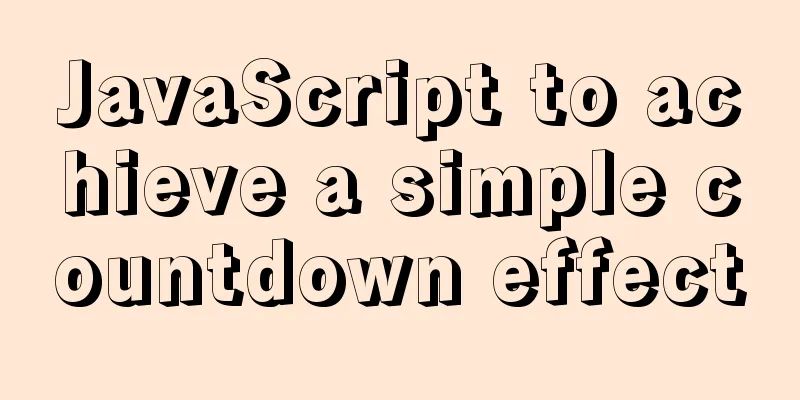JavaScript to achieve a simple countdown effect

|
This article example shares the specific code of javascript to achieve the countdown effect for your reference. The specific content is as follows Implementation ideas: 1. Create label elements for days, hours, minutes, and seconds on the page and define the styles Code example:
<!DOCTYPE html>
<html lang="en">
<head>
<meta charset="UTF-8">
<meta http-equiv="X-UA-Compatible" content="IE=edge">
<meta name="viewport" content="width=device-width, initial-scale=1.0">
<title>Countdown effect</title>
<style>
div {
margin: 200px;
}
span {
display: block;
float: left;
width: 50px;
height: 50px;
line-height: 50px;
text-align: center;
margin: 5px;
color: #fff;
background-color: rgba(0, 0, 0, .8);
}
</style>
</head>
<body>
<div class="time">
<span class="day">0</span>
<span>day</span>
<span class="hour">1</span>
<span>hours</span>
<span class="minute">2</span>
<span> points</span>
<span class="second">3</span>
<span>seconds</span>
</div>
<script>
var day = document.querySelector('.day');
var hour = document.querySelector('.hour');
var minute = document.querySelector('.minute');
var second = document.querySelector('.second');
var setTime = +new Date('2021-10-1 09:00:00');
countDown();
setInterval(countDown, 1000);
console.log(+new Date());
function countDown() {
var now = +new Date();
var times = (setTime - now) / 1000;
var d = parseInt(times / 60 / 60 / 24); //day d = d < 10 ? '0' + d : d;
day.innerHTML = d; //Give the remaining days to the day box var h = parseInt(times / 60 / 60 % 24); //When h = h < 10 ? '0' + h : h;
hour.innerHTML = h; //Give the remaining hours to the hour box var m = parseInt(times / 60 % 60); //minutes m = m < 10 ? '0' + m : m;
minute.innerHTML = m; //divide the rest into the points box var s = parseInt(times % 60); //seconds s = s < 10 ? '0' + s : s;
second.innerHTML = s; //Give the remaining seconds to the seconds box}
</script>
</body>
</html> Note: When calling the setInterval function, just write the function name. Do not write parameters in the function. If you write parameters, the function may not be executed in a loop. Page effect:
The above is the full content of this article. I hope it will be helpful for everyone’s study. I also hope that everyone will support 123WORDPRESS.COM. You may also be interested in:
|
<<: How to maintain a long connection when using nginx reverse proxy
>>: The advantages and disadvantages of nginx and lvs and their suitable usage environment
Recommend
A brief discussion on how to elegantly delete large tables in MySQL
Table of contents 1. Truncate operation 1.1 What ...
Example explanation of alarm function in Linux
Introduction to Linux alarm function Above code: ...
Detailed explanation of the use of Vue's new built-in components
Table of contents 1. Teleport 1.1 Introduction to...
Modify the default scroll bar style in the front-end project (summary)
I have written many projects that require changin...
Summary of common tool functions necessary for front-end development
1. Time formatting and other methods It is recomm...
JavaScript ES6 Module Detailed Explanation
Table of contents 0. What is Module 1.Module load...
Detailed explanation of Linux command unzip
Table of contents 1. unzip command 1.1 Syntax 1.2...
MySQL 8.0.12 installation configuration method and password change
This article records the installation and configu...
Full analysis of MySQL INT type
Preface: Integer is one of the most commonly used...
Detailed steps for QT to connect to MYSQL database
The first step is to add the corresponding databa...
Teach you how to use vscode to build a react-native development environment
question The code has no prompt: Many non-front-e...
Solution to the paging error problem of MySQL one-to-many association query
The query data in the xml price inquiry contains ...
Vue dynamically displays the day of the week corresponding to the date according to the selected month
We, humble coders, still have to sing, "You ...
Use Docker to create a distributed lnmp image
Table of contents 1. Docker distributed lnmp imag...
A brief analysis of the use of the HTML webpack plugin
Using the html-webpack-plugin plug-in to start th...










